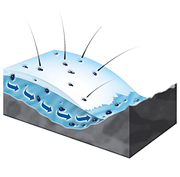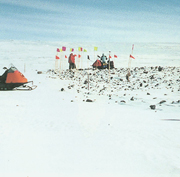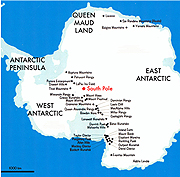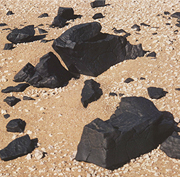Meteorites Wanted

Enlargement
In the Antarctic, meteorites are found at the base of mountainous barriers, where the movement of glaciers causes them to resurface. |
No one area of the planet receives more meteorites than another, but it is easier to find them in places without dense vegetation or dark rocks. In the sandy deserts of Africa, meteorites are easy to spot because they are uncovered by the wind, but the most wonderful collections come from the Antarctic. The snowy surface there contrasts with the black crust of the meteorites, and the ice provides excellent conditions for preserving them. Searching is made easier by the movement of glaciers, which concentrates the meteorites at the bases of the mountains. Whole fields of meteorites reveal themselves to explorers who don't mind the cold. Only scientific expeditions can go to the Antarctic; collectors called meteorite hunters travel the rest of the planet looking for meteorites.

Enlargement
Meteorite field discovered during a scientific expedition in Antarctica. |
Besides scientists and collectors, sometimes a lucky person finds a meteorite by chance. Finding iron meteorites happens the most often, because they draw more attention. Pieces of iron are rare at the surface of our planet, and they are easier to distinguish from terrestrial rocks.
 |
| Enlargement |
| Most meteorite-collecting expeditions have been made along the mountains on the coasts and continent of Antarctica. |
 |
| Enlargement |
| Fragments of the meteorite Dar al Gani 749 contrast with the Saharan dunes. |
|